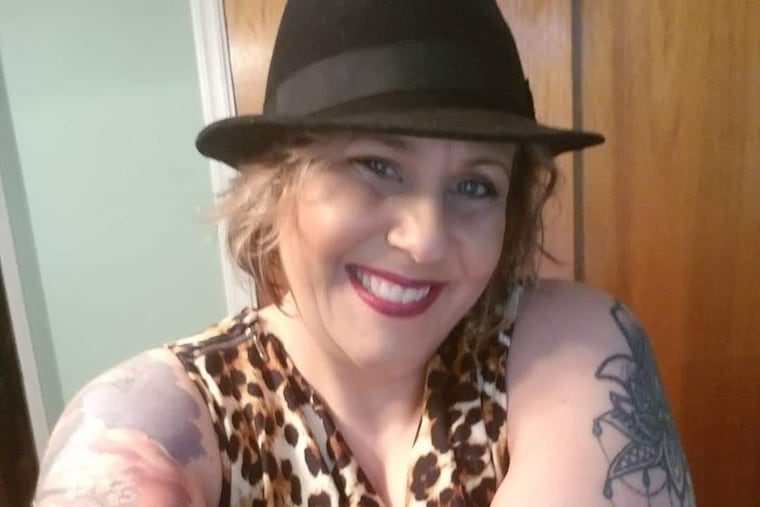A little-known problem with tattoos: The ink can complicate breast cancer screening
Tattoos are not linked to breast cancer, but they are linked to misleading mammograms.

Two years ago, when Gina Pozzi was 45, her annual mammograms suggested that she had breast cancer, the disease that killed her mother at age 47.
In addition to showing a suspicious spot in Pozzi’s right breast, the X-rays revealed white specks in her armpit lymph nodes that looked like calcium deposits — possibly a sign that cancer had spread beyond her breast.
“When cancer hits you in the lymph nodes, it’s a game-changer,” said Pozzi, who lives in Allentown. “That’s what happened with my mom. The cancer came back and went to her lymph nodes.”
Fortunately, Pozzi’s worst fears did not come true. Biopsies of her breast and lymph node tissue showed she had an early-stage, readily treatable breast tumor that had not metastasized. The harmless specks were actually ink from an elaborate tattoo covering her right arm. Her immune cells had gobbled some of the pigment and then migrated to her lymph nodes.
To be clear, there is no evidence that tattoos increase the risk of breast cancer. And as breastcancer.org explains, calcifications can be signs of harmless changes caused by breast injuries or infections, fibrous cysts, or radiation therapy. Gold injections used to treat rheumatoid arthritis and even deodorant containing aluminum can also activate immune cells that act like garbage disposers as they move through the lymphatic system.
The problem, as Pozzi discovered, is that ruling out metastatic cancer may require additional imaging and taking tissue samples for lab analysis, plus a dread-filled week or two waiting for results. Pozzi was completely unaware of the problem because state and federal regulators, the tattoo industry, breast cancer activists, and social media devoted to body art make little, if any, mention that tattoos can complicate breast cancer screening.
Because of her family history, Pozzi began getting mammograms in her 20s, decades before the X-rays are recommended for women in general. In her 30s, Pozzi began getting tattoos from a particular artist.
“I would have appreciated knowing it was a possibility that this could happen,” Pozzi said. “Would it have deterred me from getting tattooed? Probably not.”
Breast radiologists may be the one group that is familiar with the issue because so many women of middle age — prime time to start routine breast screening — now sport sizable tattoos on their upper bodies. About 40% of Gen Xers, men and women ages 41 to 56, have at least one tattoo, according to the Pew Research Center.
“I have seen [tattoo pigment in lymph nodes] many times. I think every radiologist has,” said Susan L Summerton, a radiologist with the University of Pennsylvania Health System. “The first case report was back in 2004. Now, we probably see it a couple times a month.”
Actually, that 2004 case was not the first report, contrary to the belief of the New York City radiologists who published it. Way back in 1981, the journal Radiology published “Tattoos simulating calcifications on xeroradiographs of the breast.”
Women with no family history or hints of cancer other than armpit lymph node deposits that are probably ink specks usually don’t need biopsies, Summerton said. They often react with surprise or anxiety, so Summerton explains that when a tattoo needle punctures the skin, it causes a tiny wound; the body responds by sending white blood cells to close the wound and swallow up invaders such as germs or stray pigment.
Whether lymph nodes in other parts of the bodies of inked women — and men — have flecks of pigment is unknown because those nodes are not routinely X-rayed. “If you have a leg tattoo, there is no imaging of groin lymph nodes,” Summerton said.
Eric Amicone, who has been a tattoo artist for 30 years, was taken aback when a reporter asked him about ink and mammograms.
“This is the first I’ve heard of it,” said Amicone, owner of Everlasting Art Tattoo in West Philadelphia. “And 60% of my clients are women.”
Amicone speculated that current tattoo inks are less likely to trigger the lymph node deposits because the formulations don’t rely on metals to create colors. “Now, inks are all natural and biodegradable,” he said.
It’s more complicated, according to an article published by the American Chemical Society. Historically, pigments in tattoo inks were derived from minerals and heavy metals, many with known toxicities. For example, black was made with iron oxide and red hues were made with a mercury sulfide compound.
“For the last 20 years, ink manufacturers have moved away from mineral-based pigments to organic ones,” the chemical society article explains. “Over 80% of the colorants used today are carbon-based.”
But “organic” does not necessarily mean natural or safe. For example, the article says, carbon-based Azo pigments, used to produce reds, yellows, and oranges, are known to release cancer-causing compounds as they break down, especially when exposed to the sun. A number of tattoo pigments were “originally developed for industrial applications, like paints or textiles.”
The U.S. Food and Drug Administration considers tattoo inks to be cosmetics and takes regulatory action only if the agency identifies a safety problem. Tattoo parlors are regulated by local authorities.
Pozzi, who had a lumpectomy and radiation to treat her cancer, discovered that her longtime tattoo artist was vaguely aware of the mammogram issue, but no other client reported experiencing it.
“I don’t know if it’s the responsibility of the tattoo artist or doctors or others to inform women,” Pozzi said, noting that mastectomy patients who undergo breast reconstruction often get tattoos to recreate the nipple area.
“I don’t want to be an alarmist,” Pozzi said. “I just think women should have the information.”